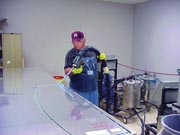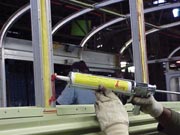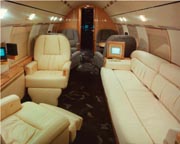Almost from Magnolia's founding in 1957, our customers have looked to benefit from the advantages chemical fastening offers over mechanical fastening. In the case of Magnolia, the chemical has been formulating epoxy adhesives. One of the first memories I have of epoxy replacing rivets, bolts, screws or other mechanical fasteners was in 1962. My father, Magnolia founder Don Wells, allowed me to drive him to see customers in the Southeast as a summer job when I was 15 years old and had just received my learner's permit.
Although I had worked in the manufacturing area of Magnolia during previous summers, this was the first time I had been exposed to the end users of the products I had helped produce, pack and ship. We visited companies building mobile box-like structures, such as manufactured housing, over-the-road trailers, school buses, recreational vehicles, motorcoaches and fire trucks. We called on makers of such diverse objects as golf clubs, residential and commercial windows and doors, and airplanes. We saw companies engaged in repairing bridges, underwater piers and other above- and below-water construction projects. All in all, it was a very enlightening summer for me, and probably a nerve-racking summer for my father, given my less-than-perfect driving skills.
I do not recall the volume of adhesives sold to augment or replace mechanical fasteners as a result of our travels 42 years ago, but I do know it is a good business for Magnolia today. Over the past several years, we have seen steady growth in the volume of epoxies we sell to augment or replace mechanical fasteners. Additional sales have come from customers whose products cannot use mechanical fasteners (such as those who adhere the tips of helicopter rotor blades to the main blade) or for whom mechanical fasteners are simply not the best option (as is the case with many composite fabricators).
There are so many places where adhesives have replaced or augmented mechanical fasteners it would be impossible to list them all. Therefore, I have chosen only a few examples of applications Magnolia is involved in on an almost daily basis.

Applications Where Mechanical Fasteners Fear to Tread:
Helicopter Rotor BladesMany newer helicopters, such as those produced by Bell Helicopter, use honeycomb sandwich rotor blades, which do not lend themselves well to mechanical means of fastening. The blades are made of an outer skin, which is bonded to a lightweight (but very strong) honeycomb sandwich structure. To reduce the effects of erosion on the blade as it spins through the atmosphere, an abrasive strip is bonded to the leading edge of the blade. Finally, the rotor blade tip, formally known as the "close-out," is bonded to the blade proper. None of this would be possible without adhesives.
Augmenting Mechanical Fasteners:
School BusesSchool bus manufacturers in North America have found that a combination of chemical fasteners (in the form of epoxy) and mechanical fasteners (in form of rivets) helps them meet the strength requirements set forth in U.S. Federal law. The United States Code defines the term "school bus" (49 U. S. C. § 30125), and the Code of Federal Regulations goes on to outline in detail standards that must be met regarding school bus construction. Title 49, Subtitle B, Chapter V, Part 571, Standard 221 addresses "school bus body joint strength" and has the stated purpose of reducing "deaths and injuries resulting from the structural collapse of school bus bodies during crashes."
The requirement to be met is that "each body panel joint shall be capable of holding the body panel to the member to which it is joined when subjected to a force of 60% of the tensile strength of the weakest joined body panel determined pursuant to" the testing method. The best means school bus manufacturers have found to meet this requirement is to augment mechanical fasteners with epoxy adhesive. In our testing, Magnolia's 6375, which was specifically formulated for school bus manufacture, is so strong that the metal test coupons fail before the epoxy fails.
We have seen a recent move in school bus manufacture toward more epoxy and away from rivets. This is due to the strength of the epoxy bond and the weakening effect riveting can have on the underlying substrate. This weakening comes about from two sources. First, in order to use rivets, the underlying metal must be perforated, which weakens the substrate - much like perforations do in perforated paper. Second, in making the rivet hole in the metal, the corrosion-resistant coating is removed and exposes the rivet joint to possible corrosion. In general, bonded joints are also less noisy over time since they will not work loose, while riveted joints will work loose as buses bounce along their routes.
Replacing Mechanical Fasteners:
General Aviation AirframesThe trend in new general aviation airframe design over the past several years has been away from mechanical fasteners and toward adhesives. The main reason for this is the increasing use of composites in airframes. Although composites can be fastened using mechanical fasteners, the results are often less than desirable, while adhesives work quite well.
In a June 12, 2003 press release, Boeing announced that its new 7E7 Dreamliner "will be the first commercial jet ever to have a majority of the primary structure - including wing and fuselage - made of advanced composite materials." The main composite will be graphite combined with a toughened epoxy resin. This use of composites will allow Boeing to imbed sensors in the airframe to monitor structural integrity for the first time on a real-time, continuous basis.
In Europe, Airbus is also increasingly turning to adhesives in the manufacture of its aircraft. One of the challenges Magnolia faced in dealing with Airbus was the directive of the European Parliament in 2001 that all products made in or destined for use in the EU be penta-BDE free. Penta-BDE was widely used as a fire retardant, which is an essential part of any adhesive designed for use on an aircraft. In a demonstration of the flexibility of epoxy formulation, Magnolia's lab quickly reformulated the epoxies destined for use in the EU to replace penta-BDE with a different fire retardant, and our Magnobond 92-1 (insert potting and edge fill) and Magnobond 6398 (liquid shim) began to widely replace brominated adhesives.
In the area of general aviation, there is a whole generation of business and personal jets either on the drawing board, in certification, or already in the air that uses composite airframes. The primary advantages of composite construction are strength, durability and aerodynamic efficiency. In many cases, there is a weight savings as well; when compared to metal construction, the strength-to-weight ratio is significantly superior.
One of the composite business jets already in the air is Raytheon's Premier I, which has been flying since 1995 and has accumulated a total of more than 23,000 flight hours. Earlier this year, Raytheon delivered its 100th Premier. The Premier is built in two composite halves and then glued together just forward of the baggage door. Another of the company's products, the Hawker Horizon, is also built with a carbon fiber composite fuselage in the same factory as the Premier.
Stepping down in size and speed, many of the newer two- and four-place general aviation piston aircraft have been designed from the beginning to use chemical fasteners on and in their composite airframes. Among these are Cirrus Design, Lancair, Diamond Aircraft and Aerocomp Inc., whose use of mechanical fasteners is primarily relegated to securing instruments in the panel and seats to the floor. However, even in securing seats to the floor, epoxy is used to affix the mounting insert to the honeycomb floor structure so that the seat support can be screwed into the insert.
While not exactly considered a part of the airframe, many general aviation airplanes, such as the Cessna Caravan, Cessna Stationair 206 and Aerocomp Comp Air 10 XL, carry underbelly cargo pods of composite construction in which epoxy is used as a fastener.
Even the new small aircraft being built for light-sport certification are primarily composite constructs that employ adhesives extensively. In fact, at the EAA's annual Airventure, held in Oshkosh, WI, and at their annual Sun-N-Fun Fly-In in Lakeland, FL, attendees can take classes on the use of adhesives in building their own aircraft.
In addition to the fuselage, epoxies are often the choice on aircraft of all sizes for parts that require high modulus and high stiffness, such as control surfaces (flaps, rudders), leading and trailing edges, and motor nacelles. Epoxies are chosen for their long durability as well. Some aircraft parts bonded with epoxy adhesives more than 40 years ago are still in good condition.

Combinations of Mechanical and Chemical Fasteners:
Commercial and General Aviation InteriorsThe interiors of both commercial and general aviation aircraft use a combination of mechanical and chemical fasteners in many areas. The overhead bins in commercial aircraft are constructed of honeycomb sandwiches made of two outer skins glued to the inner honeycomb core. At the attachment points, a router creates a hole in the honeycomb sandwich into which a metal female insert is then potted (glued) using epoxy so that the entire structure can be affixed to the fuselage using screws.
In higher-priced and better-appointed business and personal aircraft (both piston and turbine), chemical fasteners play an important part in the construction of interior amenities, such as galleys, tables, section dividers, and other interior cabinetry. As with the overhead bins in commercial aircraft, these components are primarily honeycomb sandwiches and are made and affixed to the airframe in a similar manner.
The honeycomb sandwich structure of the overhead bins and interior cabinets makes them attractive, lightweight, and strong. Although chemical fasteners could be used to glue these items to the airframe and floor just as well as mechanical fasteners, it is not practical to do so. Not only are interiors of aircraft subject to change as the owner desires, but sometimes various components must be removed to allow access to various parts of the aircraft. By and large, mechanical fasteners are designed to be removable, while most chemical fasteners are not.
Combinations of Mechanical and Chemical Fasteners:
Textile MachinesTextile machines are often leveled and secured in place using a combination of mechanical fasteners (bolts) and chemical fasteners (epoxy grout). Due to the stresses placed on the machines during textile manufacture, it is essential that the machines be level. Epoxy grout is used to level the machines and secure them to the floor. Bolts are then added as an extra measure.

Adhesives in Lieu of Chemical Fasteners
DentistryIt does not take much imagination to realize there are certain fastening needs that simply do not lend themselves to mechanical methods. Although titanium screws are sometimes used to permanently secure attachment posts to a patient's jaw for a large bridge, when was the last time you had your dentist nail down a crown in your mouth?
Recreation
In recreation, adhesives are routinely used in place of mechanical fasteners to secure golf club heads to shafts, blades to kayak paddles, outer skins to snowboards and skis, fins to surfboards, and artificial turf to concrete in sports arenas, among other applications.
Stealth
Without adhesives, the stealth technology employed on the B-2 Bomber, the F-117, and the F-22 Raptor could not exist. Today's radars are so sophisticated that the use of rivets rather than adhesives on the outer skin of these aircraft would present an identifiable target. For stealth, there is no substitute for chemical fasteners.
Alternative Energy
The European Union has set a target for 12% of the EU's primary energy to come from renewable resources by 2010, and most of that energy will be in the form of wind energy from onshore and offshore wind turbines. Throughout the United States, wind farms are being populated by large megawatt wind turbines with composite blades that use chemical fasteners. Composites are used in these turbines because they resist the elements better than traditional wooden blades, and they also provide a superior strength-to-weight ratio. Additionally, epoxy is frequently used to bond metal hubs to composite blades because epoxy can withstand the centrifugal forces exerted upon each blade, as well as resist outdoor exposure and significant temperature ranges. Epoxy is also highly resistant to stress, fatigue and aging. Wind turbine manufactures use adhesives to lower fabrication costs, increase production rates and enhance durability. For many of the same reasons, epoxy is used for maintenance purposes to minimize downtime.
Automotive
Adhesives are widely used in the automotive arena for both aesthetic and performance reasons. In 2001, a combined total of approximately 96 million dry pounds of adhesive were used in automotive interior applications in North America alone. Uses ranged from structural bonds to trim attachments to laminated constructions. It is worth noting that, despite aggressive efforts from companies providing other forms of laminating and fastening, the use of adhesives in the automobile market continues to grow.
From a performance viewpoint, the use of adhesives allows a stronger structure with less weight, which improves overall performance, safety and fuel economy. Adhesives can be found throughout automotive interiors, including in-door panels, headliners, interior pillars, seating, instrument panels and package trays. Adhesives are proficient at bonding dissimilar materials.
With the advent of electric or hybrid automobiles, lightweight strength has become even more important; this was achieved through the use of chemical adhesion rather than mechanical fasteners.
Lane Delineators (Road Buttons) and Airport Runway Lighting
Another instance where an epoxy adhesive makes more sense than a nail is in the affixing of road buttons to pavement. While most of the buttons stay down when properly bonded to the pavement, they do come up occasionally. Using an adhesive rather than a mechanical fastener reduces the chance of injury by reducing the risk of a tire puncture from the now-freed mechanical fastener.
Using similar reasoning, airport managers choose to fasten runway lights- especially those imbedded in runways- with epoxy rather than mechanical fasteners. In addition to holding the lights in place at the specified angle, the epoxy also seals the lights and the electric cables leading to the lights in the runway.

Methods of Application
The fastener itself drives methods of applying mechanical fasteners: nails get hammered, screws get screwed, etc. Chemical fastener application methods vary a bit more and can be tailored to the need. This allows chemical fasteners to be used in some areas where mechanical fastening would be difficult if not impossible, such as in an extremely tight space.In some cases, such as residential construction, an adhesive is simply sprayed on the joists prior to the plywood subfloor being nailed or screwed into place. This application is designed to decrease the incidence of squeaky floors.
In other applications, side-by-side tubes are used with a static mixing head to provide consistently mixed material to the application site. For applications requiring larger amounts of adhesive, pneumatic dispensers can be fed from 5-gal pails or drums of material.
Chemistry
Most of the epoxies we have developed over the years have been two-component epoxies with a resin part and a curing-agent (hardener) part. However, we have made- and still make- one- and three-part epoxies for certain applications. Epoxies basically consist of high-molecular-weight molecules that form a highly crosslinked matrix when cured, and provide a good balance of handling characteristics and ultimate physical properties.The chemistry of epoxy is very versatile, allowing for fast cures, slow cures, heat cures, room temperature cures and radiation cures. Epoxy can be formulated to withstand high temperatures or low temperatures; to be liquid, paste or anywhere in between; to be brittle or tough; and to be hard or flexible. Properly formulated epoxies also have high tensile and peel strength. In general, most Magnolia epoxies have a shelf life of 12 months at room temperature, although there are some that require refrigeration just to have a six-month shelf life.
Conclusion
Since epoxies were first discovered in 1943, they have gained a reputation in a host of industries that require optimum performance and reliability. In addition, epoxy chemistry is dynamic and continues to evolve. At Magnolia, our sales and lab teams find new uses for epoxies on a weekly basis. The same goes for modifications to existing products that can be used to address newly discovered needs.While an adhesive could be used to replace a mechanical fastener in almost all instances, the reverse is not true. However, there are applications where it makes more sense to use a mechanical fastener than to attempt to use an adhesive. The last garden shed I built was constructed using nails and screws - not because buckets of epoxy were not available to me, but because nails and screws were less expensive and I thought I might want to partially disassemble the shed someday to make an addition. I knew if I used epoxy to construct the shed, it would be around forever.
Rick Wells is the president of Magnolia Plastics Inc., located in Chamblee, GA, a suburb of Atlanta. Magnolia was founded by his father, Don Wells, in 1957, and was purchased by Rick in 2003. Although Rick has been involved off-and-on throughout his life, prior to purchasing Magnolia, he managed a financial-planning computer software company that he founded in 1977. Rick would like to thank Grace E. McElleney for her research and help in developing this article.
